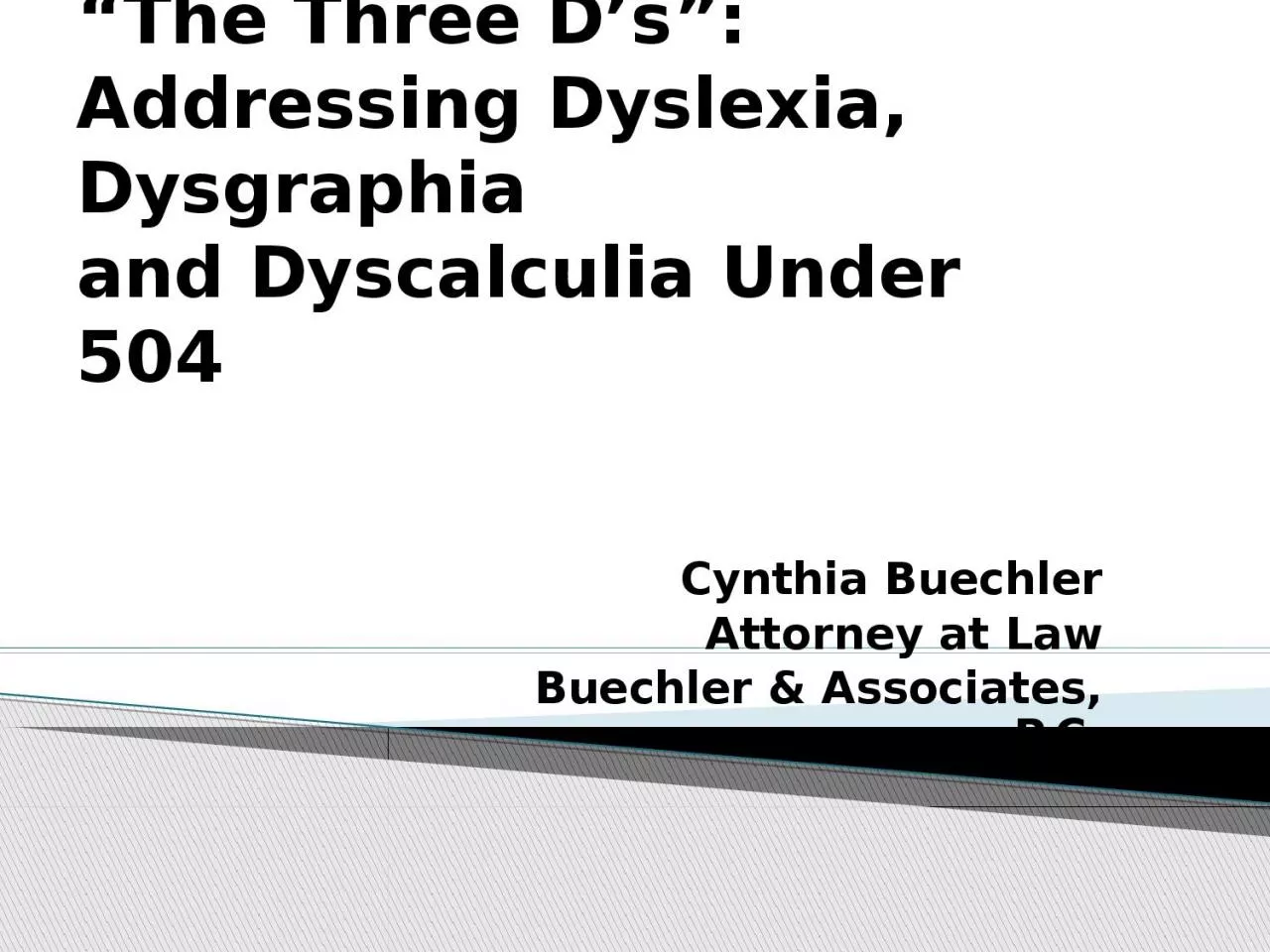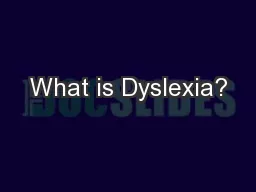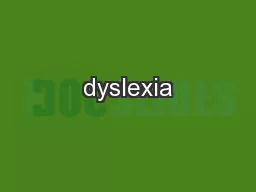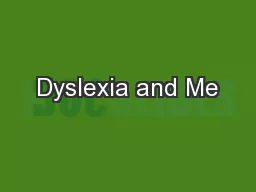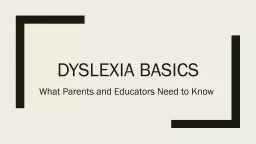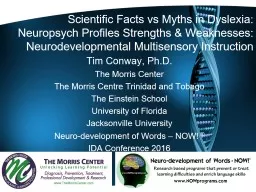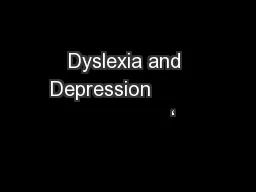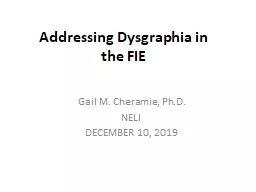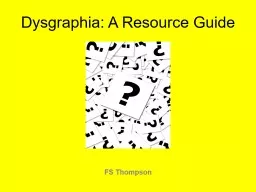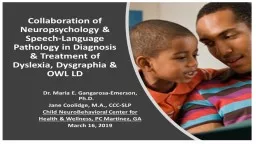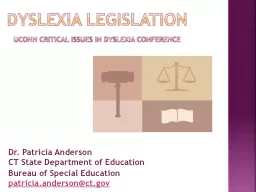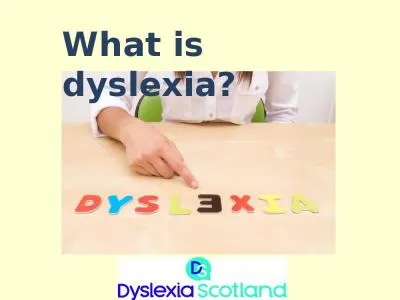PPT-“The Three D’s”: Addressing Dyslexia, Dysgraphia
Author : white | Published Date : 2024-02-09
and Dyscalculia Under 504 Cynthia Buechler Attorney at Law Buechler amp Associates PC What is dyslexia The International Dyslexia Association defines dyslexia as
Presentation Embed Code
Download Presentation
Download Presentation The PPT/PDF document "“The Three D’s”: Addressing Dyslex..." is the property of its rightful owner. Permission is granted to download and print the materials on this website for personal, non-commercial use only, and to display it on your personal computer provided you do not modify the materials and that you retain all copyright notices contained in the materials. By downloading content from our website, you accept the terms of this agreement.
“The Three D’s”: Addressing Dyslexia, Dysgraphia: Transcript
and Dyscalculia Under 504 Cynthia Buechler Attorney at Law Buechler amp Associates PC What is dyslexia The International Dyslexia Association defines dyslexia as a specific learning disability that is neurobiological in origin It is characterized by difficulties with accurate andor fluent word recognition and by poor spelling and decoding abilities These difficulties typically result from a deficit in the phonological component of language that is often unexpected in relation to other cognitive abilities and the provision of effective classroom instruction Secondary consequences may include problems in reading comprehension and reduced reading experience that can impede growth of vocabulary and background knowledge. ’. Paul Henderson – Lecturer, Faculty of Health and Social Care, Edge Hill University . SOLSTICE & CLT . Conference 2013. 5. th. & 6. th. June 2013. Introduction and overview of research study. Jessica Flegel. Parent, Advocate. Definition of Dyslexia. “Dyslexia is a specific learning disability that is neurobiological in origin. It is characterized by difficulties with accurate and/or fluent word recognition and by poor spelling and decoding abilities. These difficulties typically result from a deficit in the phonological component of language that is often unexpected in relation to other cognitive abilities and the provision of effective classroom instruction. Secondary consequences may include problems in reading comprehension and reduced reading experience that can impede growth of vocabulary and background knowledge.” . Parents’ Meeting. Wednesday 29. th. January 2014. What is Dyslexia?. . Specific Learning . Difficulty. The most common special educational need found in schools. .. It is best thought of as a continuum, not a distinct category, as there are no clear cut off points.. By Theresa . Awolesi. (. Bsc. Hons Physiotherapy). Out lined in this document are the difficulties I experience due to my dyslexia, it would be great if you could read through them so my learning style could be best supported during this placement. . and . Educators Need to Know. University of utah reading clinic. . Dr. Kathleen J. Brown. www.uurc.org. 801-265-3951. Take This to the Bank: . Good readers take in almost every word on the page. They recognize words at sight. With an unfamiliar word, they use spelling patterns to quickly chunk the word by syllable.. Neuropsych. Profiles Strengths & Weaknesses:. Neurodevelopmental Multisensory Instruction. Tim Conway, Ph.D.. The Morris Center. The Morris Centre Trinidad and Tobago. The Einstein School. University of Florida. A . specific learning . difficulty. ’ (SLD) . -. when individuals (15%) do . well in some areas of . learning, but . unexpectedly have problems . in others. ‘Dyslexia’ . or . ‘Reading Disorder’ . Gail M. . Cheramie. , Ph.D.. NELI. DECEMBER 10, 2019. Components of Written Expression. Transcription – handwriting, letter production, spelling. Executive Functions – planning, organization, monitoring, revising. FS Thompson. Dysgraphia. Origins of the word: . According to Berninger & Wolf (2009), the word ‘dysgraphia’ comes from the Greek . DYSGRAPHIA: . Primary area of difficulty in the . orthographic. system. Problems with motor memory & visual spelling patterns; may read well; poor spelling & handwriting; letter reversals; difficulty learning “sight” words; difficulty spelling short, abstract words; homophones. Poor writing skills.. Dr. Patricia Anderson. CT State Department of Education. Bureau of Special Education. patricia.anderson@ct.gov. . Public Act . 14-39. An Act Establishing the Office of Early Childhood, Expanding Opportunities for Early Childhood Education and . DYSGRAPHIA BY HANDWRITING ANANLYSIS By Abhimanshu Kumar ShaluKumari Satyam Garodia Richa Sinha UNDER THE GUIDANCE OF Mr. Rajib Saha PROJECT REPORT SUBMITTED IN PARTIAL FULFILLMENT OF THE REQUIREMENT N ovember/December 2004 by Jeri Fischer and Michael A. Rettig Common Characteristics of DysgraphiaInconsistent space between words; Slow or labored writing or copying; Cramped fingers on a writing to 1 in every 10 people has dyslexia.. It often runs in families.. Dyslexia can be.... Finding it hard to read because you can’t match sounds to the letters in words. . . . . . . and you may lose the place a lot when you try to concentrate.
Download Document
Here is the link to download the presentation.
"“The Three D’s”: Addressing Dyslexia, Dysgraphia"The content belongs to its owner. You may download and print it for personal use, without modification, and keep all copyright notices. By downloading, you agree to these terms.
Related Documents

